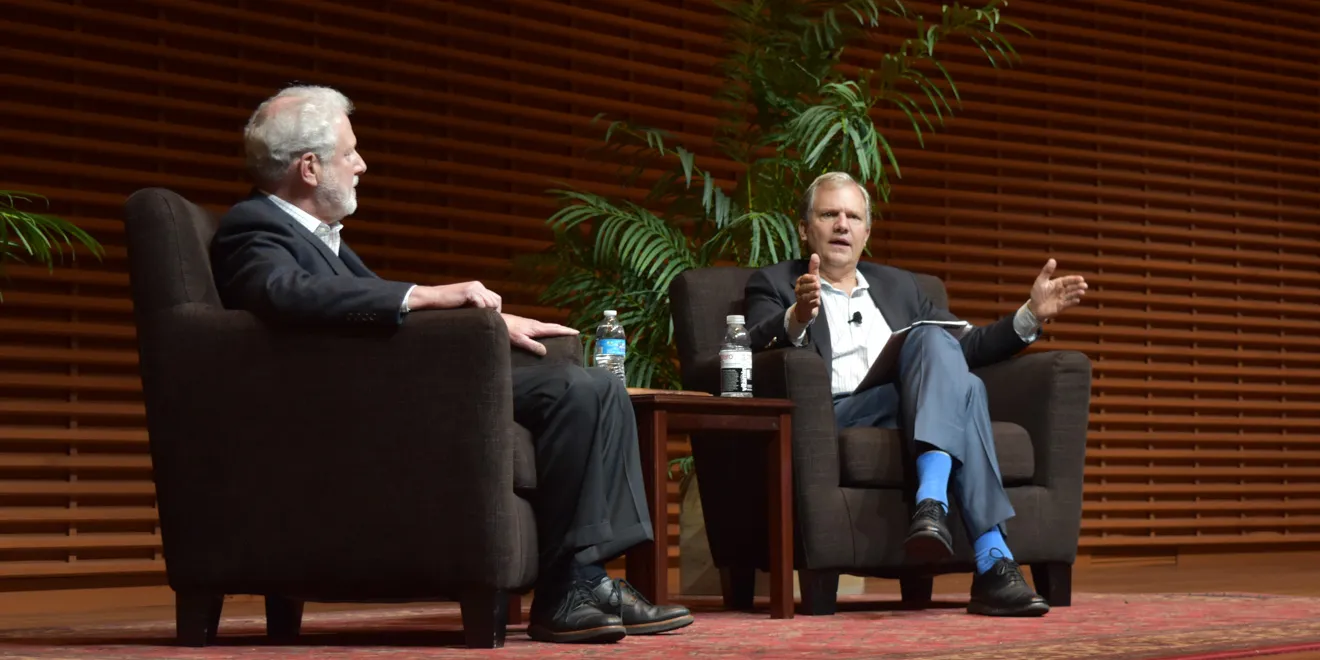Arthur Ochs Sulzberger Jr., current chairman of The New York Times Company and former New York Times publisher, spoke about polarization and hostility toward the media on Thursday night in Cemex Auditorium.
The event was co-sponsored by the communications department, John K. Knight Journalism Fellowships, Stanford Law School and Stanford Continuing Studies, and hosted by communications professor and former New York Times Washington bureau chief Philip Taubman ’70.
The overwhelming shift to digital media in recent years was a key focus of Sulzberger’s remarks. He cited the statistic that, of The Times’ 3.8 million current subscribers, almost three million only read the paper in digital form. He also spoke to the challenges that The Times has faced in monetizing this new type of readership; while ad sales constituted almost all of the paper’s profit before the digital revolution, he said that circulation now pulls in the majority of its revenue.
“In terms of the digital revolution, it was being able to find a way to embrace the fact that the business model was shifting in a dramatic way,” he said. “Whole structures that had been set up to support a very profitable business of printing the paper full of ads and getting it to your door – that model was coming undone. And that was very hard.”
Though Sulzberger confirmed that The Times benefited from an increase in readership after the 2016 election – which many in the business refer to as the “Trump Bump” – he said that the president’s hostile stance toward media is “dangerous” and “very destructive to democracy,” going so far as to call it “slander.”
Sulzberger recalled admonishing Trump’s anti-media rhetoric to the then-president-elect’s face when the two met in late 2016.
Pointing to a signed photograph of Richard Nixon, he said to Trump, “That was the last president who took on a free press – look what happened to him.”
Covering Trump’s mercurial statements and actions has also been a challenge at The Times, Sulzberger said. He explained that the decision to refer to Trump as a “liar,” given his proclivity for making false statements, was one that went all the way up to Executive Editor Dean Baquet.
“When he knowingly states a falsehood, when that falsehood is brought to his attention and he acknowledges that it’s a falsehood and then states it again and again, that’s lying,” Sulzberger said. “It’s about intent.”
Sulzberger comes from a long line of New York Times leadership; his great-grandfather bought the paper in 1896 as it was facing bankruptcy, and each generation since in the family has served as publisher. At the end of 2017, Sulzberger announced that he would be ceding his role as publisher to his son, Arthur Gregg (A.G.) Sulzberger.
Sulzberger spoke proudly of his family’s dynastic tradition at the Times, saying that their connection to the institution and connection to each other has helped maintain this longstanding unity. Taubman, who worked closely with Sulzberger, relayed an anecdote in which, in an interview with George W. Bush, Sulzberger joked to the president that one thing they shared in common was that they both had inherited their roles from their fathers.
“He did not think it was funny at all,” said Sulzberger, amid laughter from the audience.
Sulzberger discussed some of the managerial decisions he has made over the course of his career. Taubman notably asked Sulzberger about his controversial choice to oversee the dismissal of two executive editors at The Times, Howell Raines and Jill Abramson. Sulzberger said he would not be comfortable discussing the specifics of those decisions, but did say that each was made largely due to the editors’ management styles.
Sulzberger also addressed The Times’ recent decision to publish an anonymous op-ed by a senior member of the Trump administration that detailed the measures Trump’s staff members have taken to block what they see as the president’s most dangerous behavior. Sulzberger said that only four people – not including him – know who wrote the piece, but added that he is confident in the vetting process undertaken by those individuals.
“On the news side, we run anonymous sources all the time – sometimes, that’s the only way you’re going to get the information you need,” said Sulzberger. “It’s very rare to do it for an opinion piece, because for opinions it’s important to know the context.”
“We had to make sure that this was a serious enough person in the organization, at a senior enough level, that were it ever to come out who this person was … that everyone would say, ‘Okay, that made sense,’” he continued.
Despite the challenges facing The Times and other news organizations, Sulzberger predicted that time will ultimately be the solution to the country’s polarization, adding that he is “more than sanguine that the truth would prevail.”
John Woodfill Ph.D. ’92, who was also in the audience, said that he appreciated Sulzberger’s optimism that “things would fix themselves.”
Woodfill added that the challenges Sulzberger discussed “seem like such a critical issue right now, with questions about fake news and newspapers and the Trump presidency,” saying that the event was a timely one to address these issues.
“Our country splits apart and comes back together,” Sulzberger said, citing examples of immense discord such as the Civil War and the era of McCarthyism. “I have great faith in this country and great faith in all of us.”
Correction: A previous version of this article stated that The Times’ “executive editorial board,” rather than the executive editor, has considered the use of the term “lie” in the paper’s news coverage of Trump. The Daily regrets the error.
Contact Katie Keller at ktkeller ‘at’ stanford.edu.
